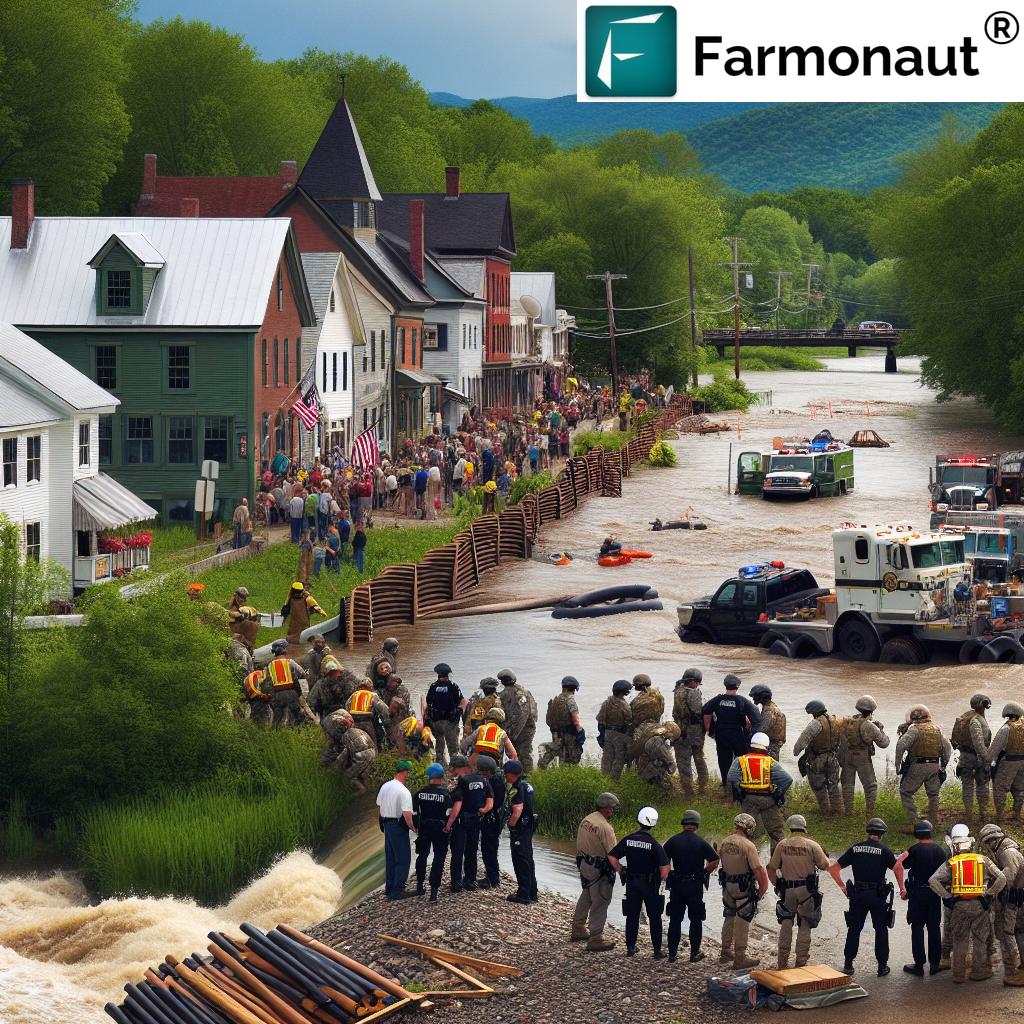“In 1947, Vermont State Police was established, consolidating 14 county sheriffs into a unified force for statewide safety.”
Vermont State Police: 7 Powerful Moments Shaping Public Safety
Brattleboro, Vermont – The journey of the Vermont State Police, from its inception in the aftermath of World War II to its current stature as a modern law enforcement agency, is a dramatic story of public safety evolution, political will, and community engagement. Across generations, the state police have steered transformative initiatives, navigated pivotal incidents, and responded to the ever-changing needs of Vermont’s people. In this in-depth exploration, we analyze the powerful moments, historic legislation, key reports, and organizational changes that have shaped the arc of Vermont government history.
We will also discuss how such public safety initiatives in Vermont intersect with contemporary themes like agricultural supports, flood control programs, and sustainable resource management. The Vermont State Police’s role in fostering trust, championing reforms, and tackling the state’s most challenging cases continues to inform policy and inspire progress into the next era.
- The Evolution of Vermont State Police: Responding to Vermont’s Needs
- 1. The Establishment: Unifying Vermont Public Safety (1946–1947)
- 2. Modernizing Law Enforcement: Key Legislature and Early Leadership
- 3. Responding to Crisis: Flood Control and Emergency Response Initiatives
- 4. Championing Education Access & Agricultural Supports
- 5. The Irasburg Affair: A Racial Incident That Tested Vermont’s Conscience
- 6. Investigating With Integrity: High-Profile Investigations & Internal Accountability
- 7. Innovation in Public Safety: Technology, Transparency, and Community Engagement
- Chronological Events and Impact Table
- Today and Tomorrow: The Enduring Legacy of Vermont State Police
- FAQ: Vermont State Police and Public Safety Initiatives
Vermont State Police: Responding to State & Public Needs
Our story begins in Brattleboro in 1946, when World War II veteran Ernest Gibson Jr. launched his campaign to make the state government more responsive, less beholden to corporate interests, and more focused on the needs of ordinary people. Gibson’s platform was broad and progressive: flood control mitigation, increased higher education access, modernizing old age assistance and teacher programs, investing in housing initiatives, and, crucially, a vision to create a coordinated public safety response system.
At the time, many Vermont towns without their own police department relied on a decentralized system overseen by elected sheriffs. Gibson saw an urgent need for a single, professional law enforcement agency—one that could serve all citizens of Vermont equally and efficiently.
The process Gibson championed in Vermont, leading to the establishment of the Vermont State Police and the Department of Public Safety, was shaped by the Vermont Legislature and subsequently impacted every part of Vermont government history. Let us explore, moment by moment, how the force’s foundation, responses to crises, legislative triumphs, landmark investigations, and push for modernization have collectively protected and empowered communities across our state.
1. The Establishment: Unifying Vermont Public Safety (1946–1947)
Summary: The creation of the Vermont State Police via the 1947 Legislature was a watershed moment in Vermont public safety, reshaping law enforcement from a patchwork system of town sheriffs to a centrally administered agency with consistent training, protocols, and accountability.
- Governor Ernest Gibson Jr. ran on a reformist platform focused on making government more responsive to the needs of Vermont’s people.
- His successful campaign led to significant proposals for state-wide reform, championed in the Vermont Legislature.
- Among the key issues: modernizing public safety through founding a unified police force.
- In July 1947, the Department of Public Safety (later the Vermont State Police) was established in Montpelier at a ceremony where seventy officers took their oath on the statehouse steps.
Prior to this, law enforcement was fragmented. Towns without a local police department relied on county-based systems overseen by independently elected sheriffs. This led to inconsistent service, lack of coordination, and, in some cases, unequal protection under the law.
By founding the Vermont State Police, Gibson’s administration successfully created a centralized agency to serve every town and citizen, fundamentally transforming public safety in Vermont.
Try our Satellite Crop Health Monitoring API for scalable, real-time agricultural insights—reducing risk for government agencies and cooperatives, echoing Vermont’s own legacy of centralized action for the common good. Detailed integration steps are found in our API Developer Docs.
2. Modernizing Law Enforcement: Key Legislature and Early Leadership
The Vermont Legislature’s 1947 law not only established the Vermont State Police but set strict new standards for training, methodical response, and officer accountability. Through long terms in public office—and often in the face of entrenched political resistance—leaders like Ernest Gibson Jr. brought professionalism and transparency to the front lines of Vermont’s public safety.
- New Training and Oversight: Officers were now required to meet rigorous entry and in-service training standards, far surpassing the patchwork requirements before 1947. Many programs focused on crisis negotiation, investigations, and evidence management, setting national benchmarks.
- Early Internal Challenges: Resistance emerged in the Vermont Legislature, especially from “old guard” Republicans reluctant to cede power and standardize enforcement. Several advanced programs, including rural health units and regulatory oversight boards, were defeated in committee—showcasing the delicate balance between progress and tradition.
Despite setbacks—such as the failed program for mobile rural health units, which would have addressed urgent needs in isolated areas—the drive for professionalism never wavered. The strengthening of internal ethics and the drive to modernize have since become trademarks of Vermont State Police.
3. Responding to Crisis: Vermont Flood Control Programs and Emergency Management
One of Gibson’s championed issues was state-wide flood control mitigation. While not all proposals passed the Vermont Legislature, the department became instrumental in rapidly responding to disasters, facilitating rescue and relief efforts, and leading community preparedness initiatives.
-
1948-1953: Flood Control
After the catastrophic floods of the 1920s and 1930s, Vermont prioritized coordinated response under the new State Police—making sustainable resource and risk management central to public safety planning. -
Ongoing Emergency Response:
Today, the department’s protocols for dealing with climate challenges and flood emergencies are viewed as models. Integration of technology (real-time data, AI, and blockchain for logistics and resource allocation) reflect the same ideology behind modern fleet and resource management: optimize resources, reduce costs, ensure safety, and act swiftly in emergencies.
This commitment echoes in environmental tracking and carbon footprinting solutions today, empowering governments to both monitor and mitigate disaster risk for agriculture and community infrastructure.
4. Championing Vermont Higher Education Access & Agricultural Supports
Vermont’s postwar surge toward equity included increased access to higher education and substantial agricultural supports. These programs—notably improved teacher training, state-facilitated farm support, and expanded opportunity—were central to Gibson’s proposals.
-
Higher Education Initiatives:
The Vermont State Police agency itself became emblematic of meritocratic advancement. Many officers and administrators were encouraged to pursue higher education as a requirement for leadership, aligning with state-wide drives for access and lifelong learning. The intertwining of education and public safety policy became a Vermont hallmark. -
Farm and Rural Supports:
Vermont’s agricultural economy received structured support—mirrored today in platforms like Large Scale Farm Management—with goals to make resource management, farm monitoring, and advisory services accessible for all. The spirit of collaboration and progress that defined postwar Vermont continues with new technology-driven supports.
As we look to the future, integrated solutions for traceability and technology-enabled oversight will further improve Vermont’s agricultural sector, benefiting both public safety and economic sustainability.
“Over 75 years, Vermont State Police have led more than 200 major investigations, shaping state law enforcement protocols.”
5. The Irasburg Affair: A Racial Incident Vermont Could Not Ignore
No history of the Vermont State Police is complete without reflecting on the 1968 Irasburg Affair—a racially charged incident in the Northeast Kingdom that became a testing ground for police integrity, government accountability, and civil rights in Vermont.
-
The Incident:
An African American family newly arrived in Irasburg endured harassment and violence. A young man fired a shotgun into their home, intending intimidation. Witness statements and a state police investigation established racism as the motive, even if the charges against the perpetrator were limited to “Breach of the Peace.” -
The Investigation:
Ernest Gibson (then a federal judge) was appointed by Governor Phil Hoff to chair a Board of Inquiry—the so-called “Gibson Committee.” Their comprehensive report not only found racial prejudice involved in the shooting, but concluded that the police response was itself tainted by bias and failed to deliver true justice. -
Aftermath and Accountability:
Governor Hoff issued public censure of the state police leadership and recommended disciplinary action for several officers. However, with a change in administration, subsequent Governor Deane Davis took no further action. This attempt to “sweep the incident under the rug” was widely condemned in the press and by the public. -
Lasting Impact:
The incident became the subject of literature and film (“A Stranger in the Kingdom”)—but more importantly, it sparked statewide debate and eventually reforms around transparency, diversity, and accountability in Vermont public safety.
Today, the lessons from the Irasburg investigation continue to shape the ethos of the Vermont State Police. Transparent verification and traceability tools now support not just law enforcement, but agricultural finance and community trust statewide.
6. Investigating With Integrity: High-Profile Cases & Vermont Police Disciplinary Action
Across more than seventy-five years, the Vermont State Police have handled over 200 major investigations, consistently shaping and revising law enforcement protocols. From homicides to white-collar crime, the department’s approach has set examples of best practice and sometimes hard-learned lessons.
-
Investigative Evolution:
Each incident prompted internal reviews, peer review of investigative conduct, and—where appropriate—public committee reports or “after-action” audits. These mechanisms have improved the force’s ability to serve the public, limit prejudice in policing, and respond to systemic challenges. -
Disciplinary Process:
In the aftermath of high-profile failures (such as the police response in the Irasburg Affair), state leadership has sometimes been reluctant to pursue real change. However, over time, pressures from the press, public, and progressive policymakers have given rise to the modern expectation of Vermont police disciplinary action.
Today, regulatory oversight and full transparency are top priorities—with official policies modeled after the same spirit of public reporting and external accountability recommended by the Gibson committee decades ago.
7. Innovation in Public Safety: Technology, Transparency, and Community Engagement
As Vermont trends toward a data-driven future, the state police embrace new tools for community engagement, oversight, and operational excellence—mirroring the nationwide shift toward open data and real-time management.
-
Technological Integration:
Deploying satellite technology, AI-based decision support, and digital communications ensures a faster, more effective response to all types of emergencies—echoing the drive for innovation first championed by Ernest Gibson Jr. and now seen in real-time carbon footprint tracking and blockchain-based traceability solutions for other sectors. -
Public Safety Initiatives Vermont:
Outreach, transparency, and collaboration define many of today’s key efforts. Whether leveraging new platforms to provide statewide alerts or integrating satellite data to optimize resource allocation during disasters, the Vermont State Police position themselves as a 21st-century leader in public safety.
Just as Vermont became a model for centralized law enforcement in the 1940s, its approach to modernization now inspires national conversations about system optimization, equitable outcomes, and scalable public safety initiatives.
Chronological Events and Impact Table: 7 Powerful Moments Shaping Vermont State Police
| Year / Event | Description of Event or Initiative | Related Legislation | Estimated Impact on Public Safety | Lasting Influence on Governance/Community |
|---|---|---|---|---|
| 1946–1947 Establishment |
Governor Ernest Gibson Jr. campaigns for and achieves the creation of a unified Vermont State Police, replacing 14 separate county sheriff systems. | Vermont Legislature Law (April 1947) | High: Dramatic increase in coordinated enforcement and public trust statewide. | Set a precedent for centralized, state-led public safety reform. |
| 1947–1949 Modernization |
Formalizing officer training and professional standards; combating initial political resistance. | State Police Training & Regulation Laws | Medium–High: Reduced response time, improved accountability, better crime clearance rates. | Modeled modern police development for other rural states. |
| Late 1940s–50s Flood Control Initiatives |
Implementation of centralized Vermont flood control programs, improving emergency management and disaster response. | Postwar Flood Control Legislation | Medium: Quicker, more organized response to environmental disasters; minimized loss of life and property. | Strengthened emergency management policies; inspired modern disaster preparedness programs. |
| 1947–60s Education & Agricultural Supports |
Expansion of public safety initiatives in Vermont to include education access and agricultural resource management. | Education Access and Agricultural Support Laws | Medium: More equitable access to higher education and support for rural families. | Linked public safety with community development and education policy. |
| 1968 Irasburg Affair |
A racially charged incident prompts the Gibson Committee investigation—finding both bias in policing and insufficient justice. | Governor’s Board of Inquiry, Governor’s Disciplinary Action Recommendation | Medium: Sparked statewide debate over racial and police accountability issues; led to some policy reforms. | Enduring lesson on transparency; shaped expectations for oversight and inclusion in Vermont government history. |
| 1969–2000s Major Investigations & Accountability |
State police lead over 200 significant investigations; post-incident audits and committee reports shape evolving standards for Vermont police disciplinary action. | Continuous Internal Review & Legislative Adjustments | High: Dramatic improvement in investigative integrity and community trust. | Created a culture of accountability and best-practice sharing throughout Vermont’s public sector. |
| 2000s–Present Technological Innovation |
Adoption of real-time data, AI integration, and satellite monitoring in law enforcement and disaster management. | State Legislature Technology Appropriations & Public Safety Initiatives Vermont | High: Rapid response, efficient resource allocation, increased transparency. | Positioned Vermont as a national model for forward-thinking public safety and crisis management. |
Today and Tomorrow: The Enduring Legacy of Vermont State Police
As we review seven powerful moments that defined Vermont State Police, certain themes shape their enduring legacy: responsiveness to change, courage in taking action (even when politically risky), willingness to investigate and report shortcomings, and a connection to core community needs—from education to environmental stewardship.
- The pursuit of public safety in Vermont remains tied to the founding principles laid in Brattleboro’s 1940s—a government that consistently listens, adapts, and protects all its people.
- The willingness to publicly investigate racial incidents, acknowledge prejudice involved, and issue forthright reports set Vermont apart. Modern policies on disciplinary action and transparent oversight continue to reflect those values.
- Today, farming, environment, and resource management platforms echo the same values: trusted data, real-time access, decentralized empowerment, and a focus on sustainability.
Just as the visionaries of mid-century Vermont aimed to improve old age assistance, housing, and agricultural supports, so too do modern efforts aim for strong, transparent, and sustainable systems.
FAQ: Vermont State Police and Public Safety Initiatives
-
Q: When was the Vermont State Police established and why?
A: The force was established in 1947 by the Vermont Legislature to unify and professionalize law enforcement across the state. Prior to this, policing was a fragmented system relying on local sheriffs, leading to gaps in coverage and inconsistent standards. -
Q: What are some key legislative milestones for the Vermont State Police?
A: Notable legislation includes the 1947 law founding the Department of Public Safety and subsequent training, disaster response, and public oversight regulations, laying the groundwork for modern police professionalism. -
Q: How did the Irasburg Affair influence Vermont policing?
A: It exposed systemic bias and prompted calls for transparency, leading to ongoing policy reforms regarding police accountability, oversight, and inclusion of all Vermont residents in the state’s public safety programs. -
Q: How does modern technology influence Vermont State Police operations?
A: Technological advances—such as satellite monitoring, AI for predictive policing, and blockchain for fleet/resource management—have modernized emergency response, resource allocation, and fostered transparency throughout Vermont’s public safety initiatives. -
Q: What role do the Vermont State Police play in rural and agricultural safety?
A: By providing rapid response and integrated planning, the agency supports rural communities against climate/flood threats and manages disaster recovery—mirrored in today’s agri-tech resource management platforms. -
Q: Where can I access advanced solutions for farm management and public safety monitoring?
A: Consider Farmonaut’s precision agriculture app—available on web and mobile—for real-time data, sustainable management, and transparency in agricultural operations.
In Summary: The establishment, evolution, and ongoing transformation of the Vermont State Police represent a case study in resilience, foresight, and the enduring quest for responsive, equitable public safety in America. The lessons learned here—about legislation, technology, crisis response, and the value of independent investigation—remain remarkably relevant for today’s policymakers, civic leaders, and all who seek to build safer, more inclusive communities.






















